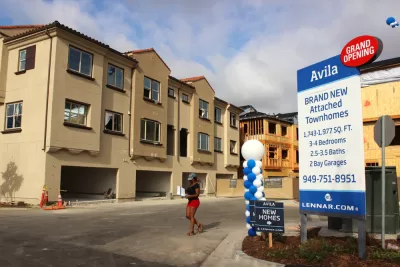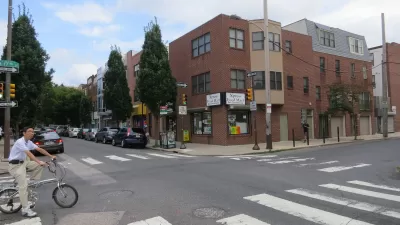New research helps explain why urban housing prices are escalating and how communities can increase affordability. It emphasizes the need to upzone sufficient urban land to create a large competitive market for parcels ready for infill development.

A new study by UCLA Professor Shane Phillips, Building Up the "Zoning Buffer": Using Broad Upzones to Increase Housing Capacity Without Increasing Land Values, emphasizes the need to maintain sufficient zoning buffer—the gap between the existing housing stock and the maximum number of homes allowed by current zoning—to increase housing affordability.
Phillips' research indicates that urban housing prices have risen because cities have downzoned, reducing the supply and driving up the price of parcels suitable for infill. For example, in 1960 Los Angeles had the zoning capacity to grow its housing stock by 300 percent; by 1980, this had fallen to 34 percent, declining to just 7 percent by 2016, as illustrated below. Downzoning did not stop population or employment growth, but it did reduce opportunities for additional housing. Over time, this shortage created our present-day housing crisis.

To combat this, many cities are upzoning to allow higher-density housing, usually in targeted locations such as along arterials or near transit stations. While this strategy may increase housing production in those areas, it can lead to higher land prices that erode the affordability of new homes. This study examines how the zoning buffer affects land values and the production and affordability of housing.
When zoning buffers are small, land with redevelopment potential remains scarce, and small-scale upzoning will cause land value increases that are largely captured by incumbent property owners. Larger-scale upzoning can create a large zoning buffer, reducing the scarcity of land with redevelopment potential, so property owners lack the leverage to demand more from a developer than a typical homebuyer. This allows developers to replace single-family houses with multiplexes, townhouses, and other types of multifamily housing, resulting in more moderately-priced development and lower housing prices.
Based on this analysis, Phillips argues that local or regional housing affordability can only be achieved through “broad upzoning,” defined as significant density increases on 25% to 50% of land in an area.
This study contributes to our understanding of why urban housing prices are escalating and how communities can increase affordability. It emphasizes the importance of scale—the need to upzone sufficient urban land—to create a large competitive market for parcels ready for moderately-priced infill development.

Manufactured Crisis: Losing the Nation’s Largest Source of Unsubsidized Affordable Housing
Manufactured housing communities have long been an affordable housing option for millions of people living in the U.S., but that affordability is disappearing rapidly. How did we get here?

Americans May Be Stuck — But Why?
Americans are moving a lot less than they once did, and that is a problem. While Yoni Applebaum, in his highly-publicized article Stuck, gets the reasons badly wrong, it's still important to ask: why are we moving so much less than before?

Using Old Oil and Gas Wells for Green Energy Storage
Penn State researchers have found that repurposing abandoned oil and gas wells for geothermal-assisted compressed-air energy storage can boost efficiency, reduce environmental risks, and support clean energy and job transitions.

Minneapolis Bans Rent-Setting Software
Four cities have enacted restrictions on algorithmic software that can inflate rent costs.

Oakland to Add 244 New EV Chargers
Oakland plans to launch its new charging network at eight locations by the end of 2025.

Jane Goodall Inspires with Message of Hope, Resilience, and Environmental Action
Speaking in Pasadena, Jane Goodall offered a hopeful and inspirational message, urging global compassion, environmental responsibility, and the power of individual action to shape a better future.
Urban Design for Planners 1: Software Tools
This six-course series explores essential urban design concepts using open source software and equips planners with the tools they need to participate fully in the urban design process.
Planning for Universal Design
Learn the tools for implementing Universal Design in planning regulations.
Heyer Gruel & Associates PA
City of Moreno Valley
Institute for Housing and Urban Development Studies (IHS)
City of Grandview
Harvard GSD Executive Education
NYU Wagner Graduate School of Public Service
City of Cambridge, Maryland
Newport County Development Council: Connect Greater Newport




























